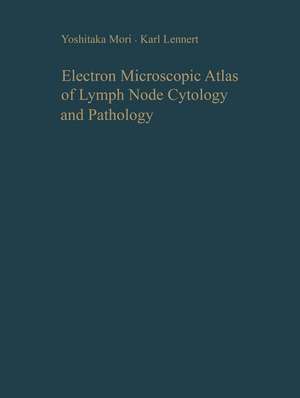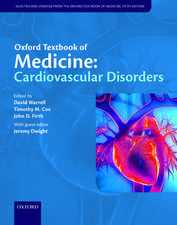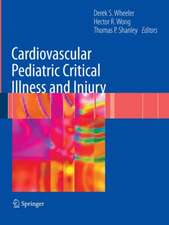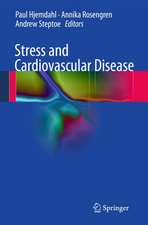Electron Microscopic Atlas of Lymph Node Cytology and Pathology
Autor Y. Mori Traducere de K. Küchemann Autor K. Lennerten Limba Engleză Paperback – 11 aug 2012
Preț: 381.35 lei
Preț vechi: 401.42 lei
-5% Nou
Puncte Express: 572
Preț estimativ în valută:
72.97€ • 76.19$ • 60.39£
72.97€ • 76.19$ • 60.39£
Carte tipărită la comandă
Livrare economică 04-18 aprilie
Preluare comenzi: 021 569.72.76
Specificații
ISBN-13: 9783642865374
ISBN-10: 3642865372
Pagini: 324
Ilustrații: XII, 310 p. 197 illus.
Dimensiuni: 210 x 279 x 17 mm
Greutate: 0.73 kg
Ediția:Softcover reprint of the original 1st ed. 1969
Editura: Springer Berlin, Heidelberg
Colecția Springer
Locul publicării:Berlin, Heidelberg, Germany
ISBN-10: 3642865372
Pagini: 324
Ilustrații: XII, 310 p. 197 illus.
Dimensiuni: 210 x 279 x 17 mm
Greutate: 0.73 kg
Ediția:Softcover reprint of the original 1st ed. 1969
Editura: Springer Berlin, Heidelberg
Colecția Springer
Locul publicării:Berlin, Heidelberg, Germany
Public țintă
ResearchDescriere
,,1m Kleinsten die wirkliche Wahrheit gibt graBen Gedanken erst Klarheit" KARL THOMAS Each year sees the publication of hundreds of reports of experimental work on the lymphatic tissue, yet morphological studies of the cells involved can be counted on the fingers of one hand. Furthermore, anyone who tries to identify these cells by morphological criteria is accused of sophistry and hair splitting, whereas it is accounted scientifically correct and unbiased to speak of "lymphoid cells", "blast cells" etc. Not so many years ago things were different: there were too many names and too many classifi cations and everyone backed his particular fancy. People thought of cells in terms of rigid classes, nothing then being known about the transformability of mononuclear blood cells. Today we must look for the middle way: cells should be named and defined according to morpho logical criteria but their transformation potential should be borne in mind. Once the cells are analysed and subdivided, it will be simple enough to set up proper classifications afterwards. This book arose out of the conviction that there should be more criteria and more information available on the morphology of human lymphoreticular cells; previously such information had been restricted by the difficulty of the special hematological and cytochemical staining methods.
Cuprins
Material and Methods.- The So-Called Normal Lymph Node.- I. The Cell Types.- 1. Lymphocyte.- 2. The Characteristic Cells of the Germinal Centers.- a) Germinocyte.- b) Germinoblast.- c) Desmosome-connected (Long-branching) Reticulum Cell.- 3. Basophilic Stem Cell (Large Pyroninophilic Cell).- 4. Plasma Cell Series.- a) Plasma Cell.- b) Proplasmacyte.- c) Plasmablast.- 5. Reticulum Cell.- a) Nonphagocytic Reticulum Cell.- b) Phagocytic Reticulum Cell.- 6. Retothelial Cells.- a) Retothelial Cells of the Marginal Sinus.- b) Retothelial Cells of the Intermediate and Medullary Sinus.- 7. Mast Cell.- 8. Other Cell Types.- II. The Main Structural Units of the Lymph Node.- 1. The Follicles.- 2. The Pulp.- 3. The Lymph Sinuses.- 4. The Blood Vessels.- Nonspecific Lymphadenitis (Reactive Hyperplasia).- 1. Follicular Lymphatic Hyperplasia.- 2. Diverse Hyperplasia of the Pulp.- 3. Plasma Cell Hyperplasia (Plasmacytosis).- 4. Sinus Catarrh.- 5. Immature Sinus Histiocytosis.- Specific Lymphadenitis.- 1. Tuberculosis.- 2. Sarcoidosis.- 3. Toxoplasmosis (Piringer’s Lymphadenitis).- Hodgkin’s Disease.- 1. Mixed Type.- 2. Nodular Sclerosing Type (Lukes).- 3. Epithelioid Cellular Lymphogranulomatosis.- Malignant Tumors of the Lymphoreticular Tissue.- 1. Germinoblastoma (Follicular or Nodular Lymphoma, M. Brill-Symmers).- 2. Lymphosarcoma.- 3. Reticulum Cell Sarcoma.- 4. Burkitt’s Tumor.- 5. Macroglobulinemia of Waldenström.- Leukemias.- 1. Chronic Lymphocytic Leukemia.- 2. Poorly Differentiated Leukemias and Erythremias.- a) Lymphoblastic Type.- b) Granulocytic (Paramyeloblastic) Type.- c) Monocytic Type.- d) Undifferentiated Type.- e) Acute Erythremia (Di Guglielmo’s Disease).- Histiocytosis X.- 1. Letterer-Siwe’s Reticulosis of Infants.- 2. Eosinophilic Granulomatosis of the Adult (Lipoid Granuolmatosis of Hand-Schüller-Christian without Lipoid Storage).- Tumor Metastases.- 1. Lymphoepithelial Carcinoma (Schmincke-Régaud).- 2. Squamous Cell Carcinoma.- 3. Malignant Melanoma.- References.- Illustrations.










